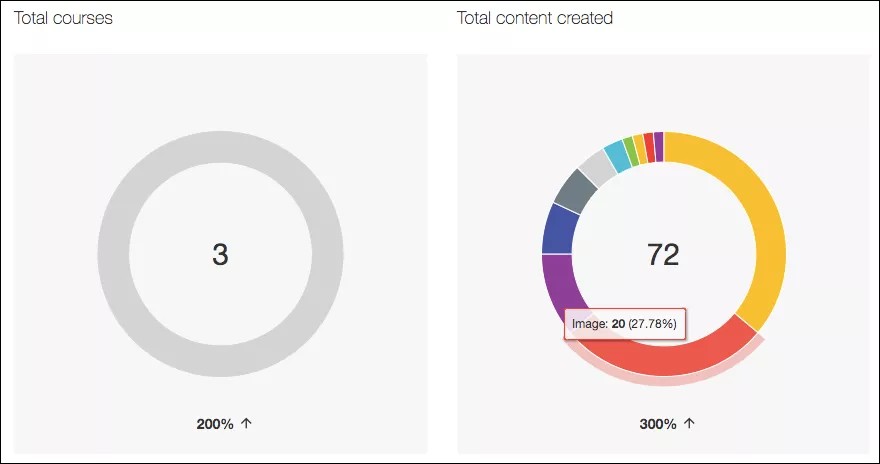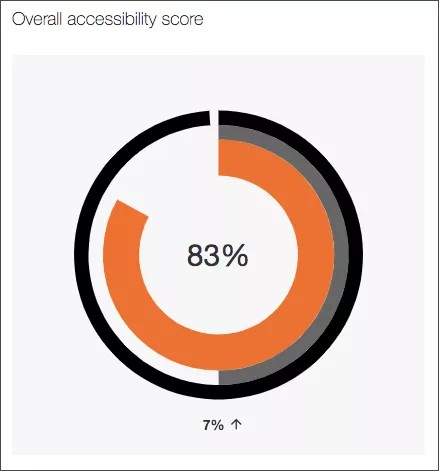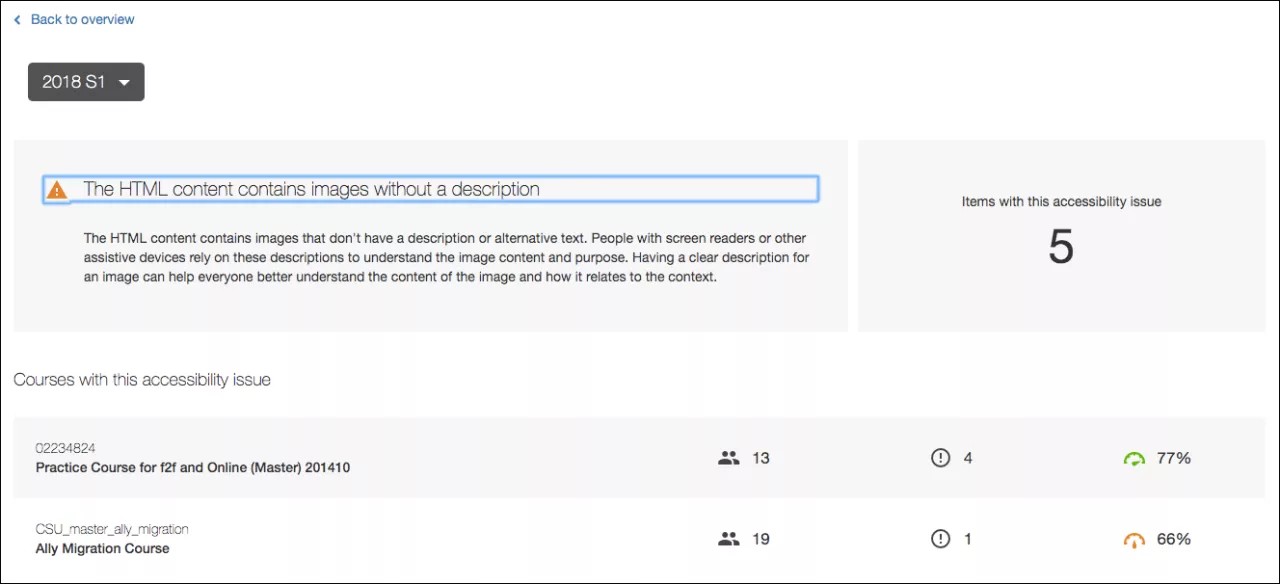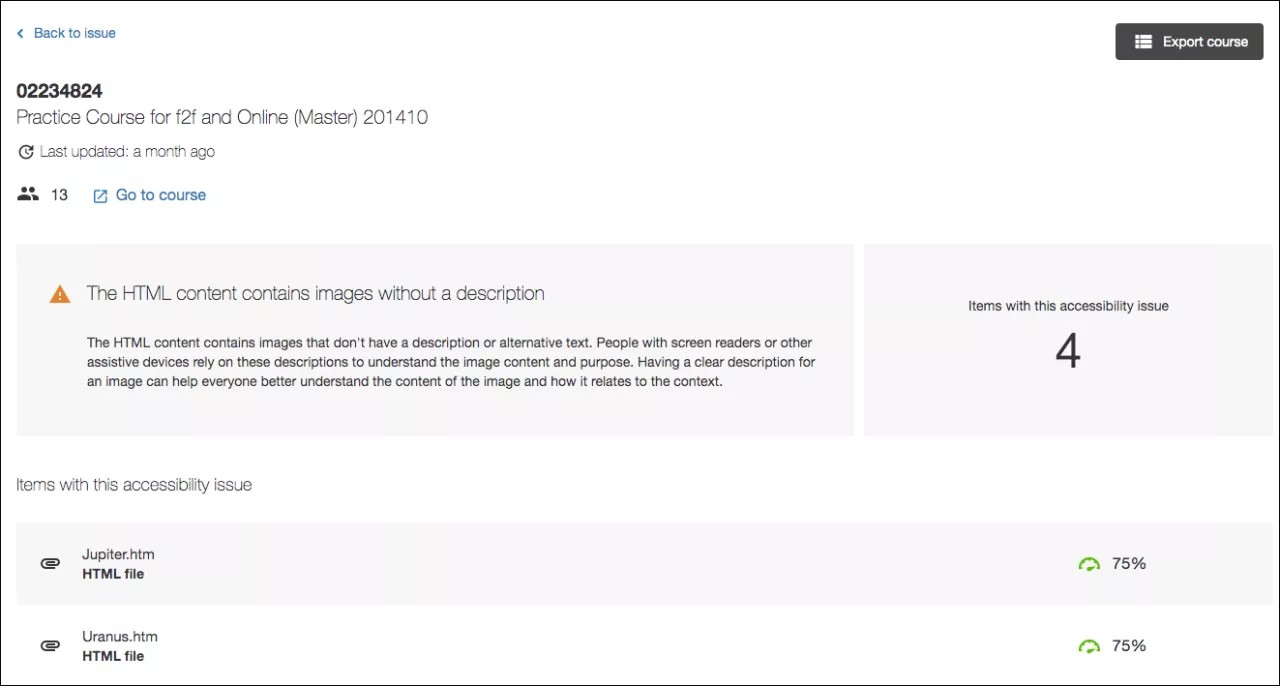The overview shows you how digital course content at your institution is performing by month, term, or academic year. It shows you the overall accessibility score, the total number of courses and content created, as well as accessibility issues found.
Use the period type menu to view the report by month, term or academic year. Export the report for more details.
Deleted courses appear in the month and academic reports only and are marked as deleted. Deleted courses don't appear in the term report.
Accessibility score
This line graph shows the accessibility score for all LMS course content over a select period of time. Select By month to compare over many months, By term to compare terms, or By academic year.
- Month accessibility score: The average of the accessibility scores of all content items that were added during that month.
- Term accessibility score: The average of the accessibility scores of all content items that live in courses associated to that term.
-
Only terms with associated courses and content show in the report. Terms that don't have any courses or content are hidden from the report. This includes deleted courses. Deleted courses aren't in the term report or contribute to the term's accessibility score.
- Academic year accessibility score: The average of the accessibility scores of all content items that were added during that academic year.
The higher the score the better your content is performing. Point to a period on the line graph to see the scores in percentage %. You can also check or uncheck the boxes WYSIWYG, Files or Overall to compare specific data in any specific period.
- WYSIWYG: The average score for (HTML) content created through the Learning Management System (LMS) content editor.
- Files: The average score for uploaded file content. For example, PDFs, Word documents, PowerPoint presentations, images, and so on.
- Overall: The average combined accessibility score for both files and WYSIWYG content.
With your keyboard, press Tab to navigate through each period on the graph. Press Spacebar to select it.
Total courses and content created
View the total number of new and updated content items in the Total content created report. View the number of courses with new and updated content items in the Total courses report. Each report compares the current period to the period before.
In the Total content created report, color represents different content types. Point to a content type to see the total number created and an accessibility score for that type.
Screen reader users can press Tab to move through the hidden Total content created table.
Select a new period from the Accessibility score line graph or current period menu to view a different period.
Overall accessibility score
View the accessibility score for the selected period. See how your content performs and if the overall score has gone up or down compared to the previous period.
Select a new period from the Accessibility score line graph or current period menu to view a different period.
Accessibility issues
See a list of accessibility issues found in the selected period. Select a new period from the Accessibility score line graph or current period menu to view a different period.
Issues are listed in order of priority from severe to minor. Those at the top of the list should be addressed first. Ally looks at the number of students impacted, how often the issue occurs, and the accessibility score to determine the priority. Select Severe, Major, or Minor to sort the issues by severity.
- Severe. These issues are the greatest risk to accessibility and require the most attention.
- Major. These issues impact accessibility, and while not severe, require attention.
- Minor. These issues should be considered for a better accessibility score.
At-a-glance you can determine basic information for each issue.
- Content type and accessibility issue
- Severity
- Total number of content with the issue
Select an issue to see a full description of the issue and the courses impacted.
From the Courses with this accessibility issue table, you see the course ID and name, the number of students enrolled and impacted by the issue, the number of items in the course with the issue, and the accessibility score.
Select Back to overview to return to the Ally institution report overview. Select the report period menu to compare courses with this issue in a different period.
Select a course to see the course items with this issue.
See the number of students enrolled in the course and a list of items with the accessibility issue.
Select Back to issue to return to the Course with this accessibility issue list. Select Export course to download the individual course report. Select an item to see the item in question. Select Go to course to visit the course homepage and use Ally instructor feedback to improve the accessibility of the item.
Improve an item's accessibility
Go to the institutional report in your LMS. From the Accessibility issues table, find a specific content item in a course with an accessibility issue. Select the content item's accessibility score indicator to open the feedback panel.
This feature is disabled by default. Submit a request on Behind The Blackboard to have it turned on. This feature is only available when accessing the institutional report from the LMS and not when using the direct access URL.
Why are decorative images still listed in the accessibility issues?
When creating content from your LMS, you can add images and mark them as decorative when they don’t add further information to your course content.
Once you mark any image as decorative, the accessibility score will be raised to 100%, some attributes such as alt text of that image will be automatically updated, and some accessibility issues that may exist will no longer need to be fixed.
When checking the status of your courses from the Course Accessibility and Institutional Report, the same image marked as decorative will be listed under the accessibility issues with Major Severity. The intent of this is to serve as a more comprehensive view of the content of all your courses and increase awareness of accessibility best practices, as an image should, for the most part, have a purpose within content, not just as decorative.











 加入 Ally 用户小组
加入 Ally 用户小组